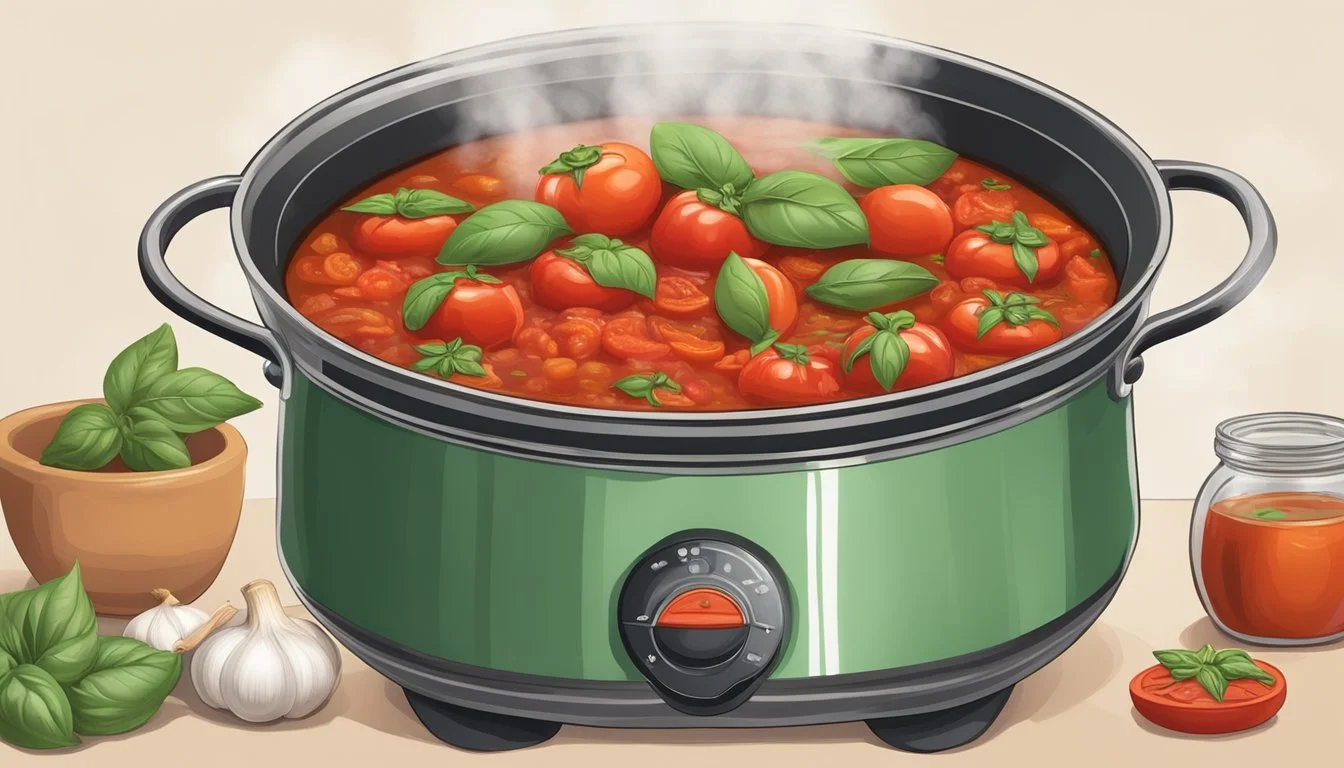How to Cook with San Marzano Tomatoes
Mastering Authentic Sauces
San Marzano tomatoes are prized in Italian cuisine for their sweet flavor, firm pulp, low seed count, and distinctive shape. Often hailed as the gold standard for tomatoes, they are grown in the rich volcanic soil at the base of Mount Vesuvius. Their unique taste and texture make them ideal for creating authentic Italian tomato sauce. Originating from the small town of San Marzano sul Sarno, these tomatoes have been used in Italian cooking for centuries, reflecting a legacy of culinary tradition.
When cooking with San Marzano tomatoes, it's important to recognize the balance of simplicity and technique. An authentic Italian tomato sauce recipe typically relies on a minimal number of high-quality ingredients to highlight the natural flavors of the tomatoes. Olive oil, garlic, fresh herbs, and a pinch of salt can complement the San Marzanos, allowing their rich and sweet profile to become the star of the sauce.
The process of making the sauce from San Marzano tomatoes involves careful preparation, from sautéing garlic to a precise simmering that enhances the depth of flavor. Whether the tomatoes are crushed by hand or puréed, the goal is to maintain the integrity of their taste. Ensuring a low and slow cooking approach allows for the development of a sauce that is both robust and refined, capable of elevating any pasta dish to an authentic Italian experience.
Understanding San Marzano Tomatoes
San Marzano tomatoes are revered in culinary circles for their distinctive qualities, especially in creating authentic Italian sauces. This section explores their background, unique characteristics, and how to discern genuine San Marzano tomatoes.
History and Origin
San Marzano tomatoes hail from the small town of San Marzano sul Sarno, located near Naples in Southern Italy. They were first grown in volcanic soil in the shadow of Mount Vesuvius, a factor many believe contributes to their unique flavor. This variety of plum tomatoes has been appreciated in Italy since the 18th century and it eventually gained recognition worldwide.
Characteristics and Qualities
What sets San Marzano tomatoes apart is their bright red color, elongated shape, and a sweet flavor that's less acidic than other varieties. They are known for having fewer seeds and a thicker flesh which makes them less watery and ideal for sauces. When cooked, they break down beautifully creating a rich and smooth texture.
Certified vs Non-Certified
When purchasing San Marzano tomatoes, it's important to look for the 'DOP' label, which stands for Denominazione di Origine Protetta or Protected Designation of Origin. This certification ensures the tomatoes are grown and processed in their native region of Southern Italy, adhering to strict standards. Canned San Marzano tomatoes with a 'DOP' label and a "Product of Italy" stamp are certified and often considered to be of higher quality compared to non-certified ones.
Preparing for Your Sauce
Creating an authentic sauce with San Marzano tomatoes begins with the careful selection of high-quality ingredients and the decision between using fresh or canned tomatoes.
Selecting Ingredients
When it comes to authentic Italian sauces, the selection of ingredients is paramount. One should aim for freshness and quality to ensure the best taste. For a classic San Marzano tomato sauce, the essential ingredients include:
San Marzano tomatoes: Recognized for their sweet flavor and low acidity.
Olive oil: A good quality extra virgin olive oil is preferred for its rich taste.
Garlic: Fresh cloves are desirable for a more robust flavor.
Onion: Usually a yellow onion, finely chopped for its sweet taste when sautéed.
Carrot: A single carrot can add natural sweetness, reducing the need for added sugars.
Fresh herbs: Basil is a staple, but one may also consider oregano or thyme for additional layers of flavor.
Incorporating these ingredients ensures a sauce with depth, sweetness, and authentic Italian character.
Canned vs Fresh San Marzano Tomatoes
The debate between using canned versus fresh San Marzano tomatoes hinges on availability and convenience.
Canned San Marzano Tomatoes
Pros: Consistent quality, available year-round, and pre-peeled.
Cons: Some brands may add preservatives; quality varies, so one should look for a DOP (Protected Designation of Origin) label if authenticity is a concern.
Fresh San Marzano Tomatoes
Pros: Fresh flavor, can be more aromatic, and allows for customization on skin removal and texture.
Cons: Seasonal availability, requires additional preparation to peel and deseed.
Ultimately, a cook’s choice between canned and fresh San Marzano tomatoes should be guided by the desired flavor profile of the sauce and the practicalities of the cooking situation.
Building the Flavor Base
The foundation of any authentic sauce with San Marzano tomatoes lies in building a robust flavor base. This involves careful sautéing of aromatics and a judicious selection of herbs and spices to enhance the natural sweetness and acidity of the tomatoes.
Sautéing Aromatics
To begin, chefs heat olive oil in a saucepan over medium heat. Finely minced garlic cloves and diced onion are then added to the oil. The key is to cook them until they are just softened and aromatic, which usually takes about 2 to 3 minutes. It is crucial to stir constantly to prevent the garlic from burning, as this would introduce a bitter flavor into the sauce.
Olive oil: 2 tablespoons
Garlic cloves: 3-4, minced
Onion: 1 medium, diced
1. Heat the olive oil over medium heat.
2. Add the minced garlic and diced onion.
3. Sauté until softened, for about 2-3 minutes.
Using Herbs and Spices
Once the garlic and onion are sautéed, it’s time to season the sauce. Herbs like basil, oregano, and thyme are essential for an authentic flavor profile. Each herb should be added according to taste but generally in moderation to not overpower the sauce. A small pinch of red pepper flakes can be introduced as well for a subtle heat, along with black pepper and salt to enhance the overall flavor of the sauce. If the tomatoes are particularly acidic, a pinch of sugar might be needed to balance the flavors.
Salt: to taste
Black pepper: to taste
Red pepper flakes: a pinch (optional)
Herbs (freshly chopped or dried):
Basil: 1 tablespoon
Oregano: 1 teaspoon
Thyme: 1 teaspoon
1. Season with salt and black pepper to taste.
2. Add a pinch of red pepper flakes for heat (optional).
3. Incorporate basil, oregano, and thyme.
Building a rich flavor base sets the stage for San Marzano tomatoes to shine in any Italian sauce. The aromatics should be translucent and golden, and the herbs and spices perfectly measured to create a harmonious foundation for the tomatoes to be added.Creating the Sauce
When crafting an authentic San Marzano tomato sauce, the two crucial steps involve cooking down the tomatoes to develop flavor and adjusting the consistency to achieve the desired thickness.
Cooking Down Tomatoes
To begin, one must choose high-quality San Marzano tomatoes for their rich and sweet profile. The tomatoes are first sautéed in olive oil with garlic to enhance their natural flavors. It is important that the garlic is not burnt but rather cooked until fragrant. After sautéing, the San Marzano tomatoes—either fresh blanched and peeled or canned—are added to the pot.
Method:
Sauté minced garlic in olive oil for 30-60 seconds.
Add tomatoes to the pot; fresh tomatoes should be blanched, peeled, and seeds removed.
Simmer the mixture, partially covered, stirring occasionally.
The slow cooking process allows for the tomatoes to break down and meld with the aromatics, such as basil and oregano, creating a sauce that is both simple and complex in taste.
Achieving the Perfect Consistency
The consistency of tomato sauce is key to its culinary application. To achieve a smooth and thick sauce, it may be necessary to use a food processor, blender, or immersion blender. After blending, return the sauce to the pot and continue simmering until it reaches the desired thickness.
Tips for Consistency:
Use a blender for a smoother sauce or mash the tomatoes for a more textured feel.
Consistency can be adjusted by the amount of time allowed for the sauce to simmer and reduce.
Adding a pinch of sugar can balance the acidity, while salt and pepper are adjusted to taste.
Through patient simmering and periodic stirring, the sauce thickens to a rich and velvety texture that is ideal for coating pasta or as a base for other dishes. During the last few minutes of cooking, additional fresh basil can be stirred in for a burst of flavor.
Incorporating The Sauce into Dishes
Once you've mastered making San Marzano tomato sauce, it becomes a versatile base that can enhance a variety of Italian dishes, from a robust main course to a simple side. Knowing how to incorporate it can elevate your cooking to new heights.
Authentic Italian Recipes
The richness of San Marzano sauce shines in classic Italian recipes. Use it as a pasta sauce; it clings beautifully to spaghetti or fettuccine, offering a bright, rich flavor in every bite. When making lasagna, layer the sauce between sheets of pasta and ricotta cheese for an authentic taste. The sauce also pairs well with meatballs, either as a topping or simmered within it to absorb its flavors. For pizza, replace your typical pizza sauce with San Marzano sauce to create a more genuine and nuanced pizza sauce. Even in soups, such as minestrone, the sauce can be added to provide a deep tomato base.
Alternative Uses for San Marzano Sauce
Beyond traditional Italian dishes, San Marzano tomato sauce can enhance a variety of meals. Its robust flavor makes it an excellent choice for a main course, like chicken parmesan (What wine goes well with chicken parmesan?) or eggplant rollatini, where the sauce complements the main ingredient. Simplify its use for a side dish; blend it until smooth and serve as a dipping sauce with mozzarella sticks or garlic bread. The sauce's versatility extends to braised dishes (What wine goes well with braised dishes?), where its acidity can tenderize and add complexity to the proteins. In more creative twists, one can incorporate San Marzano sauce into marinara sauce for stews or to add a touch of Italian flair to otherwise non-traditional dishes.
Storing and Preserving San Marzano Tomato Sauce
Proper storage techniques are crucial for maintaining the flavor and quality of your San Marzano tomato sauce. Whether preserving it short-term in the refrigerator or for months at a time in the freezer or pantry, understanding the best practices ensures that your sauce stays as fresh as the day it was made.
Refrigeration and Freezing
For immediate use, storing your San Marzano tomato sauce in the refrigerator is ideal. When refrigerated in an airtight container, the sauce can typically last up to one week. Ensure that the container is sealed to prevent the sauce from absorbing other flavors and odors.
For long-term preservation, freezing is an excellent method. The sauce should be cooled to room temperature before transferring it to a freezer-safe container or bag. Here's how to freeze the sauce effectively:
Pour the sauce into a freezer-safe container or heavy-duty freezer bag.
Leave about ½ inch of space at the top as the sauce will expand when frozen.
Seal tightly, label with the date, and freeze.
Frozen sauce maintains its quality for up to six months.
Canning and Shelf Life
Canning San Marzano tomato sauce extends its shelf life significantly, allowing you to enjoy the fruits of your labor for up to a year or more. When canning, it is vital to follow safe canning practices to prevent the growth of bacteria.
Here are the steps for canning your sauce:
Sterilize the jars and lids.
Fill the jars with hot sauce, leaving about ½ inch of headspace.
Wipe the rims clean, place the lids on the jars, and screw the bands until fingertip tight.
Process the jars in a boiling water canner or pressure canner according to USDA guidelines.
Once processed, store in a cool, dark place.
Canned sauces should be used within one year for best quality. Always check for signs of spoilage like off odors, colors, or textures before using.
By applying these storage techniques, the integrity and flavor of San Marzano tomato sauce can be preserved for both immediate enjoyment and future culinary use.
Serving Suggestions and Pairings
San Marzano tomatoes yield a sauce with a rich flavor that is perfect for Italian cuisine. When it comes to serving, choosing the correct pasta and accompanying embellishments can elevate the dish to new heights.
Choosing the Right Pasta
When selecting pasta, consider the texture and shape in relation to the sauce's consistency. San Marzano tomato sauce pairs well with long and thin pastas like spaghetti or linguine, as their shape allows the sauce to cling effectively. For a heartier choice, tubular pastas such as penne or rigatoni are ideal for capturing the sauce within their hollow structures.
Spaghetti: A classic that highlights the sauce.
Linguine: Similar to spaghetti, but slightly flatter.
Penne: Great for a more textured dish.
Rigatoni: Perfect for holding onto thick sauce.
Accompaniments and Garnishes
The sauce's rich flavor is complemented by a variety of side dishes and garnishes. Garlic bread serves as a splendid side, perfect for absorbing the sauce's nuances. When it comes to garnishes, a sprinkling of freshly grated Parmesan cheese adds a salty, umami element, while a few leaves of fresh basil contribute a refreshing contrast and vibrant color.
Garlic Bread: Ideal for mopping up excess sauce.
Parmesan Cheese: Enhances the dish with a salty depth.
Fresh Basil: Offers a burst of freshness.
Drizzling extra virgin olive oil over the finished dish can add a fruity, peppery note that complements the natural sweetness of the San Marzano tomatoes. Whether serving as a main course or side dish, these guidelines ensure a memorable culinary experience.
Final Tips and Tricks
Preparing dishes with San Marzano tomatoes can elevate them to an authentic Italian quality. Below are targeted strategies for enhancing the depth of flavor and avoiding common pitfalls.
Enhancing Flavor Over Time
A chef's secret for attaining rich and complex tastes lies in allowing sauces to simmer. When one lets a sauce made with San Marzano tomatoes simmer low and slow, the flavors concentrate and meld, creating a delicious and authentic Italian flavor that is essential for a family recipe. It is typical for recipes to suggest simmering the sauce with a pinch of salt and some fresh basil for about 40 minutes. However, one should tailor the time based on the desired consistency and depth of flavor.
Common Mistakes to Avoid
To ensure that the San Marzano tomatoes maintain their versatile and staple role in Italian cooking, one must also be cognizant of the common errors that could compromise quality ingredients.
Overcooking Garlic: Sauté garlic briefly, about 30-60 seconds, to avoid bitterness.
Improper Storage: Freeze peeled tomatoes properly to preserve them for up to 6 months.
Skin and Seeds: Blanch and peel tomatoes, removing seeds as preferred to ensure a smooth sauce.
Sugar Balance: Add a small amount of sugar, if necessary, to balance the tomato's acidity.
Adhering to these tips will make certain that meals harness the authentic Italian flavors that San Marzano tomatoes are celebrated for.
Conclusion
In the realm of Italian cuisine, San Marzano tomatoes hold a revered spot for creating authentic and delicious sauces. The simplicity in preparing San Marzano tomato sauce is one of its greatest strengths; it allows the rich, robust flavors to shine through without the need for complex techniques. A knowledgeable cook recognizes that the quality of ingredients is paramount, and these tomatoes are no exception.
The slow simmering process, typically conducted over low heat, ensures that the sauce thickens naturally, enhancing both flavor and texture. To truly honor the tradition, one should always look for genuine San Marzano tomatoes, characterized by their elongated shape and sweet, less acidic taste. It is these defining qualities that contribute to a genuinely authentic Italian sauce.
Here's a quick checklist to ensure you capture the essence of San Marzano tomato sauce:
Select San Marzano tomatoes, either fresh or canned, for their distinct taste.
Sauté garlic gently to avoid bitterness, enhancing the sauce's foundation.
Incorporate fresh herbs like basil for an aromatic touch.
Simmer low and slow, allowing the sauce to develop its signature profile.
By adhering to these principles, one can create a truly remarkable culinary experience. The simplicity of the ingredients and method belies the depth of flavor achieved; this is the art of Italian sauce-making at its most genuine.
Cooking with San Marzano tomatoes offers a journey through the rich tapestry of Italian culinary tradition, providing an authentic, simple, and delicious touch to any dish that calls for quality tomato sauce.








